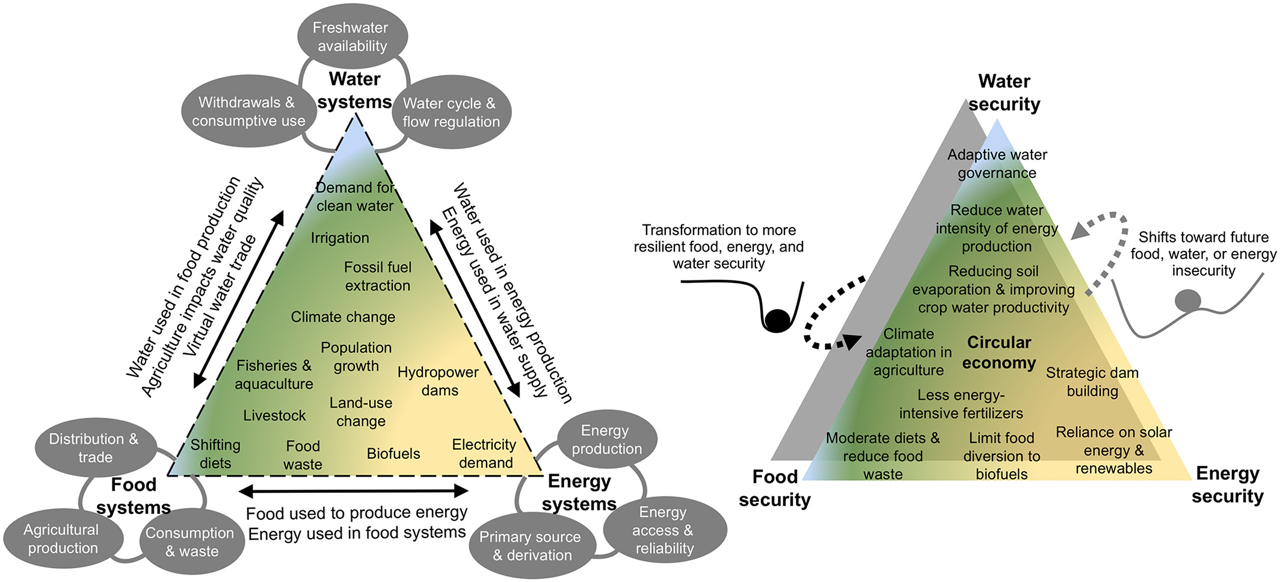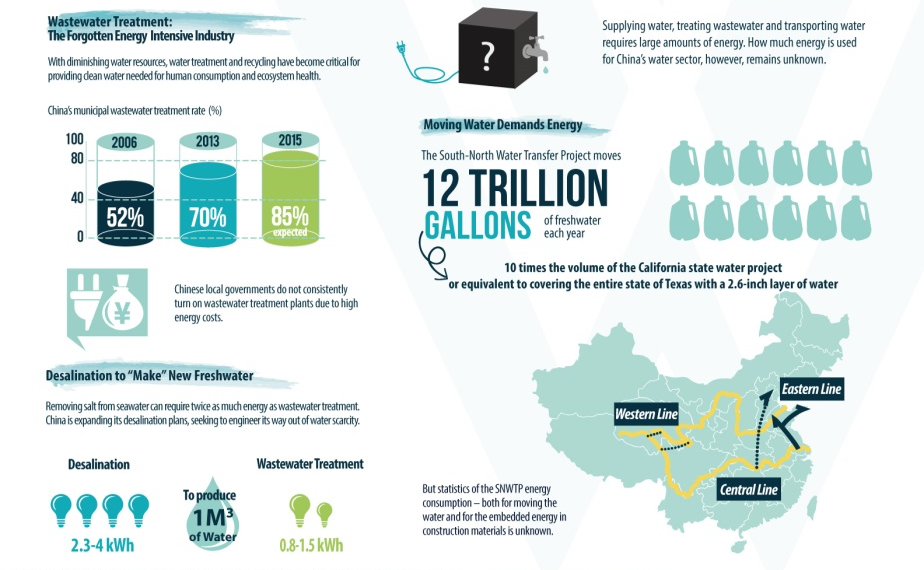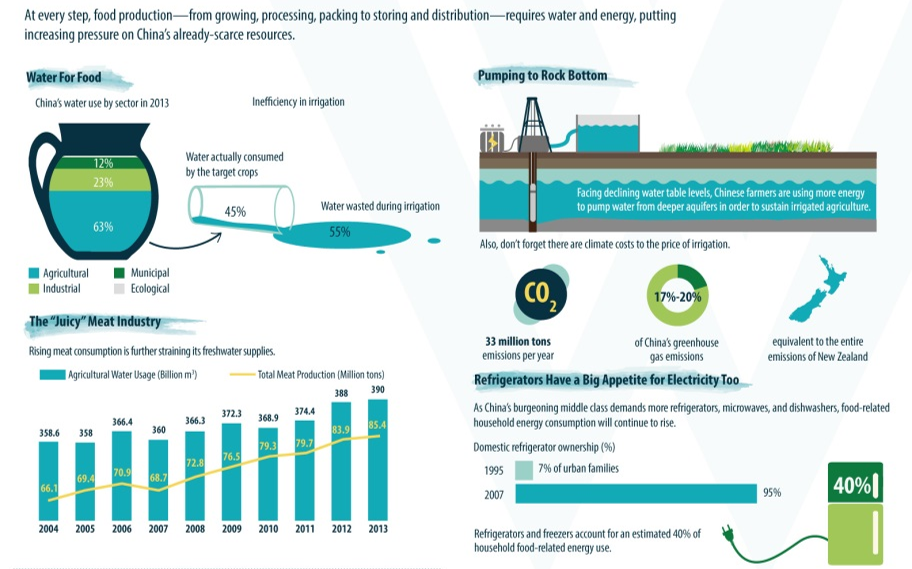Introduction
Climate change is an increasingly pressing issue worldwide, and China is no exception. The country has seen rising temperatures, more frequent and severe weather events, and changes in precipitation patterns, all of which have significant impacts on the water, energy, and food systems. In response, the Chinese government has implemented various policies and strategies aimed at adapting to and mitigating the effects of climate change, while also promoting sustainable development.

China’s green development agenda, which was launched in 2014, aims to balance economic growth with environmental protection and social development, with a focus on transitioning to a low-carbon and circular economy. The water-energy-food nexus is a key area of focus in this agenda, as it is essential to sustainable development and has significant implications for climate change adaptation. China, as the world’s largest greenhouse gas emitter, is particularly vulnerable to the impacts of climate change. The country has recognized the urgency of addressing climate change and has made it a priority in its green development agenda. However, climate change adaptation is a complex and multifaceted challenge that requires the integration of various sectors, including water, energy, and food, known as the water-energy-food (WEF) nexus.
In recent years, China has made significant efforts to address the WEF nexus in the context of climate change adaptation. These efforts have included policy initiatives, technological innovations, and institutional reforms. For example, the government has established a range of targets and regulations to reduce greenhouse gas emissions and promote renewable energy and energy efficiency. It has also implemented measures to improve water resource management and promote sustainable agriculture.
However, despite these efforts, there are still significant challenges to overcome in achieving sustainable development in the face of climate change. These challenges include the need for further integration of policies and initiatives across different sectors, as well as the need for greater investment in innovative technologies and institutional reforms. Additionally, the impacts of climate change on the WEF nexus are expected to continue to evolve and intensify in the coming years, requiring ongoing adaptation and resilience-building efforts.
Climate Change and Its Impacts on Water, Energy, and Food Systems
Climate change has significant impacts on water, energy, and food systems, which are closely interlinked in what is known as the water-energy-food (WEF) nexus. In China, these impacts are particularly pronounced due to the country’s size, population, and vulnerability to natural disasters.
Water systems are particularly vulnerable to climate change, with changes in precipitation patterns and temperatures leading to altered hydrological cycles, increased water scarcity, and more frequent floods and droughts. The impacts on water systems can have cascading effects on energy and food systems, as water is necessary for energy generation and agriculture.

In China, the impacts of climate change on water resources are particularly acute due to the country’s large population and rapid economic growth. The following are some specific impacts of climate change on water resources in China:
- Climate change has led to changes in precipitation patterns in China, including increased frequency and intensity of extreme weather events such as droughts and floods. These changes have led to more variable and unpredictable water availability for human use and agriculture.
- Higher temperatures and changing precipitation patterns have led to a reduction in water availability in many regions of China. For example, the Yellow River, which is one of the most important water sources for China’s agriculture and industry, has experienced significant reductions in flow due to climate change.
- Climate change can also impact water quality by altering water temperature, pH, and dissolved oxygen levels. Changes in these factors can lead to the growth of harmful algal blooms, increased water treatment costs, and the spread of waterborne diseases.
- The retreat of glaciers and degradation of permafrost due to climate change can also impact water resources in China. These changes can lead to changes in streamflow, water availability, and the quality of water in rivers and lakes.
In addition to the direct impacts on water quantity and quality, climate change can also lead to changes in the timing and intensity of precipitation, which can have significant impacts on water availability and management in China. For example, changes in precipitation patterns can affect the timing and duration of floods and droughts, which can have significant impacts on agricultural productivity and water availability for other uses.
According to a study by the Asian Development Bank, climate change is expected to cause significant changes in water availability in China, with some regions experiencing more frequent and severe droughts and others experiencing increased flooding. This is expected to have significant impacts on water availability for agriculture, energy production, and other sectors. In addition to changes in water availability, climate change can also have significant impacts on water quality, particularly in regions where water resources are already under stress. For example, changes in temperature and precipitation patterns can lead to changes in water quality and nutrient levels, which can have significant impacts on aquatic ecosystems and human health. Overall, the impacts of climate change on water resources in China are expected to be significant and far-reaching, highlighting the need for effective adaptation strategies and sustainable water management practices.
Climate change is expected to have a significant impact on energy systems, particularly in China where the energy sector is a major contributor to the country’s economy. One of the main impacts of climate change on energy systems is the increase in temperature, which can lead to increased demand for cooling and air conditioning, and decreased demand for heating. This, in turn, can lead to increased energy consumption, particularly during the summer months, and increased greenhouse gas emissions.
Another impact of climate change on energy systems is the change in precipitation patterns, which can affect the availability of water for hydropower generation. This can result in decreased power generation from hydroelectric dams, which could have significant economic and environmental impacts.

Extreme weather events such as heat waves, droughts, and floods can damage energy infrastructure, such as power plants, transmission lines, and substations, leading to disruptions in energy supply. For example, in 2013, heavy flooding in Sichuan province caused a major power outage, affecting millions of people. According to a study by the Chinese Academy of Sciences, climate change is expected to have a significant impact on China’s energy supply, with the potential to reduce hydropower capacity by up to 40% in some regions and decrease the efficiency of thermal power plants by up to 10%. The study also predicts that the total energy demand in China will increase by 50-70% by 2050 due to population growth and economic development.
In addition to hydropower, climate change can also affect China’s other energy sources, including coal, natural gas, and renewable energy. Higher temperatures can reduce the efficiency of thermal power plants, which rely on water for cooling, by decreasing the availability and increasing the temperature of cooling water (Zhang et al., 2018). Climate change can also affect the distribution of renewable energy resources, such as wind and solar power, which can be impacted by changes in wind patterns and cloud cover (Zhang et al., 2017). These impacts on China’s energy systems can have significant economic and social consequences, as well as implications for energy security and greenhouse gas emissions.
To mitigate these impacts, China has implemented several policies and initiatives aimed at reducing greenhouse gas emissions and promoting the use of renewable energy sources such as wind, solar, and hydropower. For example, the country has set a target to increase its non-fossil fuel energy consumption to 20% by 2030 and has invested heavily in renewable energy technologies.
The Water-Energy-Food Nexus in China’s Green Development Agenda
China’s Green Development Agenda and Its Focus on The Nexus
The green development agenda in China aims to promote sustainable economic growth while reducing environmental impact and resource consumption. It recognizes the interconnections between water, energy, and food systems, and seeks to address these interconnections through an integrated approach. One of the key strategies for achieving this is the development of a circular economy, which promotes resource efficiency and reduces waste in all sectors. The circular economy is seen as a way to mitigate the impacts of climate change on the water-energy-food nexus, while also creating new economic opportunities.
China’s green development agenda has highlighted the importance of managing the water-energy-food nexus in a sustainable and integrated manner to promote environmental protection, economic development, and social progress. The Chinese government has recognized the interdependence of these sectors and the need to adopt a holistic approach to address their challenges and opportunities. In 2015, China launched the “Belt and Road Initiative” (BRI), a global infrastructure and development project aimed at promoting regional connectivity and cooperation. The BRI includes a focus on the water-energy-food nexus and encourages the adoption of sustainable and integrated solutions in the participating countries.
Moreover, China’s 13th Five-Year Plan (2016-2020) highlights the need to build a green and low-carbon economy, reduce environmental pollution, and improve resource efficiency. The plan emphasizes the importance of adopting circular economy principles, promoting clean energy, and enhancing water and food security. To achieve these goals, the Chinese government has introduced various policies and programs, such as the “Circular Economy Promotion Law,” the “National Clean Energy Fund,” and the “Water Pollution Prevention and Control Action Plan.” These initiatives aim to promote the adoption of sustainable and integrated approaches in the water-energy-food nexus and to incentivize innovation and investment in these sectors.
The green development agenda is supported by a range of policy initiatives, including the 13th Five-Year Plan for Economic and Social Development, the Belt and Road Initiative, and the Paris Agreement on climate change. These policies aim to reduce greenhouse gas emissions, improve energy efficiency, promote renewable energy, and encourage sustainable land use and water management practices. Additionally, the government has established targets for reducing water and energy consumption and increasing the use of renewable energy sources.
Overall, the green development agenda in China recognizes the importance of the water-energy-food nexus in achieving sustainable economic growth and seeks to address the challenges and opportunities presented by this nexus through an integrated and holistic approach.
The Interconnections Between Water, Energy, and Food Systems in China
Water, energy, and food systems in China are interconnected, and their interactions and interdependence need to be carefully considered for sustainable development. Water is essential for energy and food production, and energy is required for water treatment, transport, and distribution. Similarly, food production relies on water and energy inputs, and energy is required for food processing and distribution.
China’s water resources are under pressure due to population growth, industrialization, and climate change. The country is home to approximately 20% of the world’s population but only 7% of the world’s freshwater resources. As a result, water scarcity is a significant challenge in many regions of the country, particularly in the arid north and northwest. This scarcity has implications for the energy and food sectors, as both rely heavily on water resources. For example, the production of coal, oil, and gas requires large amounts of water for extraction and processing, while hydropower generation is a major source of electricity in China.

In the food sector, water scarcity can lead to lower crop yields and reduced agricultural productivity, as well as increased competition for water resources between agriculture and other sectors. Additionally, water pollution from industrial and agricultural activities can impact both the availability and quality of water resources, further exacerbating water stress.
China’s water, energy, and food systems are intricately connected, as they rely on each other in various ways. Water is needed for energy generation, such as hydropower and cooling in thermal power plants, and for irrigation in agriculture. Energy is required to pump and transport water for irrigation, treatment, and distribution, and to process and transport food. Food production requires both water and energy for irrigation, processing, and transportation. The interconnections between these systems are further exacerbated by climate change, as it impacts water availability, energy generation, and agricultural productivity. Therefore, the sustainable management of the water-energy-food nexus is critical to ensure a secure and resilient future for China’s development.
Challenges and Opportunities in Managing the Nexus in China
There are several challenges in managing the water-energy-food nexus in China, including:
- China is facing significant resource scarcity due to its rapidly growing population and economic development. This scarcity is particularly evident in water resources, which are essential for agriculture, industry, and energy production.
- Climate change is causing significant disruptions to the water, energy, and food systems in China, including increased frequency and intensity of droughts, floods, and extreme weather events.
- Water pollution is a significant challenge in China, particularly in urban areas, where industrial and agricultural activities contribute to high levels of contamination.
- China is heavily reliant on coal for energy production, which has significant environmental and health impacts. The government is seeking to transition to cleaner sources of energy, such as renewables, but this transition is slow due to the high cost and technical challenges.
- China is facing significant challenges in ensuring food security, particularly in the face of a rapidly growing population, urbanization, and changing dietary patterns.
- There is often a lack of coordination and integration between different government agencies, as well as between different sectors, leading to inefficiencies and conflicts.
- There is a lack of reliable and consistent data on water, energy, and food systems, which makes it difficult to make informed decisions and develop effective policies.
- There are limited financial and technical resources available for implementing nexus approaches, particularly at the local level.
- Societal and cultural barriers may also pose challenges to the implementation of nexus approaches, such as a lack of awareness or understanding of the interconnections between water, energy, and food systems.
- Climate change and variability further exacerbate the challenges in managing the nexus, as extreme weather events and changes in precipitation patterns can have significant impacts on water availability and energy and food production.
- Climate change and associated impacts, such as more frequent and intense droughts and floods, disrupt the balance of water, energy, and food systems.
- There are also infrastructure and technology limitations, particularly in rural areas, that can hinder the implementation of nexus approaches, such as a lack of access to modern irrigation systems or renewable energy technologies.
- Pressures from rapid urbanization and economic development, lead to increased demand for water, energy, and food, and further exacerbate the competition and interdependency between the sectors.
- Outdated and inefficient infrastructure and technologies in water, energy, and food systems, resulting in resource waste and environmental pollution.
- Inadequate institutional frameworks and governance mechanisms to address the complex and dynamic nature of the nexus.
Addressing these challenges will require a coordinated and integrated approach, with a focus on improving data availability and quality, building capacity and resources, raising awareness and understanding, and investing in infrastructure and technology.
There are several opportunities for managing the water-energy-food nexus in China, including:
- China has made significant investments in renewable energy, particularly in wind and solar power. These investments can help to reduce reliance on fossil fuels and improve the sustainability of the energy system.
- China has implemented various water-saving technologies, such as drip irrigation and water-efficient appliances, which can reduce water demand in the agriculture and domestic sectors.
- Sustainable agriculture practices, such as crop rotation and conservation tillage, can improve soil health and reduce water and energy use in the agriculture sector.
- Integrated planning and management of water, energy, and food systems can help to identify and address interconnections and trade-offs between the different sectors.
- The circular economy approach, as discussed earlier, can promote resource conservation, reduce waste and pollution, and create new economic opportunities.
- Technological innovation can provide new solutions for managing the water-energy-food nexus, such as new water treatment technologies or energy-efficient appliances.
- Encouraging public participation and awareness can promote sustainable behaviors and practices, such as water and energy conservation, and reduce demand for the resources of the nexus.
- The interconnectivity of the nexus provides opportunities for integrated planning and management, which can lead to more efficient resource use and environmental sustainability.
- The circular economy approach can promote resource conservation and reduce waste and pollution, while also generating economic benefits and job opportunities.
- The increasing availability and affordability of renewable energy technologies, such as solar and wind, can help decarbonize the energy system and reduce greenhouse gas emissions.
- Technological innovations, such as precision agriculture and smart water management systems, can improve the efficiency and sustainability of water and food systems.
- The growing public awareness and demand for sustainable development and green products can create market opportunities and incentivize companies and governments to adopt more sustainable practices.
By addressing these opportunities, China can improve the sustainability and resilience of its water, energy, and food systems, while also supporting its green development agenda.
Climate Change Adaptation Strategies for the Water-Energy-Food Nexus in China
Water Management Strategies
Water management strategies for climate change adaptation in the water-energy-food nexus in China include;
- Encouraging the reuse of treated wastewater for non-potable purposes, such as agriculture and industry, can reduce the pressure on freshwater resources and ensure more sustainable use of water.
- Implementing water conservation measures, such as efficient irrigation systems, water-saving technologies in industrial processes, and household water conservation campaigns, can help reduce water demand and promote more sustainable use of water resources.
- Investing in water infrastructure, such as water storage and distribution systems, can improve the reliability and resilience of water supplies, especially during periods of drought and other climate-related extreme weather events.
- Adopting an integrated water resources management approach that considers the interconnections between water, energy, and food systems can help optimize the use of water resources and minimize conflicts over water use.
- Investing in green infrastructure, such as wetlands and green roofs, can help reduce the risk of flooding and erosion, enhance water quality, and provide other ecological benefits.
- Implementing water pricing policies that reflect the true cost of water can help promote more efficient use of water resources and encourage water conservation.
- Developing a more transparent and equitable water rights system can help reduce conflicts over water use and ensure a more sustainable allocation of water resources.
- Integrated water resources management (IWRM) is a comprehensive and participatory approach that aims to optimize water resource utilization, management, and protection. The implementation of IWRM in China has increased in recent years, with policies and guidelines aimed at promoting sustainable water resource management.
- Various measures can be implemented to reduce water consumption and increase efficiency, such as water pricing mechanisms, water-saving technologies, and infrastructure improvements.
- The reuse and recycling of water in different sectors can contribute to reducing water stress, increasing water availability, and improving water quality. In China, the government has implemented policies and initiatives to promote water reuse, such as the “Water Saving Society” campaign.
- Rainwater harvesting is an effective way to augment water resources and reduce runoff. In China, the government has promoted rainwater harvesting as a key component of urban water management.
- Ecosystem-based approaches aim to protect and restore natural ecosystems, such as wetlands and forests, to maintain water availability and quality. The implementation of ecosystem-based approaches in China has increased in recent years, with policies and initiatives aimed at protecting and restoring ecosystems.
- Water allocation and management mechanisms aim to ensure equitable and sustainable water allocation among different sectors and regions. In China, the government has implemented various policies and mechanisms to regulate water allocation and management, such as the “Three Red Lines” policy and the water permit system.
- International cooperation can provide opportunities for sharing experiences, knowledge, and resources and promoting joint efforts to address water challenges. China has engaged in various international cooperation initiatives on water management, such as the Belt and Road Initiative and the China-ASEAN Water Resources Cooperation Fund.
Overall, these water management strategies can contribute to addressing the water challenges in the water-energy-food nexus in China and promote sustainable development.
Energy Management Strategies
In addition to water management strategies, energy management strategies are also important for climate change adaptation in the water-energy-food nexus in China. The following are some key strategies:
- Renewable energy development: Promoting the development of renewable energy sources such as solar, wind, and hydropower can help reduce the greenhouse gas emissions associated with traditional fossil fuel-based energy generation.
- Energy efficiency: Improving energy efficiency in buildings, industry, and transportation can help reduce energy demand and associated emissions.
- Smart grids: Developing smart grids that allow for more efficient and flexible management of energy resources can help optimize energy use and reduce waste.
- Energy storage: Investing in energy storage technologies can help ensure a reliable and stable supply of energy from intermittent renewable sources such as wind and solar.
- Combined heat and power (CHP): Encouraging the development of CHP systems can help increase energy efficiency by using waste heat from electricity generation for heating or cooling.
- Implementing these energy management strategies can help reduce greenhouse gas emissions, increase energy efficiency, and ensure a more reliable and sustainable energy supply in China’s water-energy-food nexus.
- Renewable energy development: The government could incentivize the development and implementation of renewable energy sources such as wind, solar, and hydropower to reduce the reliance on fossil fuels and decrease greenhouse gas emissions. This could be done through policies such as feed-in tariffs or tax credits for renewable energy projects.
- Energy efficiency improvements: Improving energy efficiency in industries such as agriculture, food processing, and water treatment can reduce energy consumption and greenhouse gas emissions. This could be done through government subsidies or regulations that require energy-efficient equipment and processes.
- Integrated energy planning: Integrated energy planning can optimize energy systems to reduce water usage and improve food production. For example, using waste heat from power plants for greenhouse heating or using biogas from livestock manure for electricity generation.
- Demand-side management: Encouraging the adoption of energy-efficient appliances and practices can reduce overall energy demand and costs. This could be done through public education campaigns or financial incentives such as rebates for purchasing energy-efficient appliances.
- Smart grid technology: Implementing smart grid technology can improve energy efficiency and reliability while also integrating renewable energy sources into the grid. This could be done through government investment in smart grid infrastructure or partnerships with private companies.
- Energy-water nexus management: Integrated management of energy and water systems can optimize resource use and reduce overall demand. For example, using water from hydropower plants for irrigation or cooling water from power plants for industrial processes.
- Carbon capture and storage: Implementing carbon capture and storage technologies in power plants and other industries can reduce greenhouse gas emissions and mitigate the impacts of climate change. This could be done through government funding for research and development or through regulations that require the use of carbon capture technologies.
- Circular economy practices: Adopting circular economy practices in energy systems, such as reusing waste heat or recycling materials, can reduce resource consumption and greenhouse gas emissions. This could be done through government incentives or regulations that promote circular economy practices.
Food System Management Strategies
Adapting the food system to climate change in China requires a multifaceted approach that integrates climate-smart agricultural practices, sustainable land use, and improved food processing, storage, and distribution. Some potential strategies for managing the water-energy-food nexus in the food sector include;
- Promoting sustainable agriculture practices, such as precision irrigation, agroforestry, conservation tillage, and integrated pest management, can reduce water and energy use, enhance soil health, and increase crop yields.
- Supporting small-scale and local food systems can reduce the energy and water consumption associated with long-distance transportation and storage. Additionally, promoting traditional and indigenous food systems can support local food diversity and food security.
- Reducing food waste can reduce energy and water consumption throughout the food system. Strategies for reducing food waste can include improved food storage, processing, and distribution, as well as consumer education campaigns.
- Developing sustainable food processing technologies, such as solar-powered dryers and anaerobic digesters, can reduce energy consumption and greenhouse gas emissions in the food processing industry.
- Promoting sustainable land use practices, such as agroforestry and conservation agriculture, can reduce soil erosion and water runoff, increase soil carbon sequestration, and enhance biodiversity.
- Developing crop varieties that are more resilient to climate change, such as drought-resistant crops, can reduce water and energy consumption and enhance food security.
- Promoting sustainable aquaculture practices, such as integrated multi-trophic aquaculture and recirculating aquaculture systems, can reduce water consumption and environmental impacts associated with traditional aquaculture practices.
- Implementing sustainable agricultural practices such as conservation tillage, crop rotation, and cover crops can help reduce soil erosion, increase soil fertility, and reduce greenhouse gas emissions from agricultural activities.
- Supporting the development of local food systems can reduce the carbon footprint of food transportation, support local farmers, and increase food security.
- Implementing strategies to reduce food waste, such as better food storage, reducing portion sizes, and composting, can reduce the environmental impact of food production and consumption.
- Encouraging the consumption of plant-based diets can reduce greenhouse gas emissions from animal agriculture and improve public health.
- Building food system resilience through diversification of crops and production systems, and improving post-harvest infrastructure and storage facilities can help ensure food security in the face of climate change impacts.
- Implementing sustainable irrigation practices, such as drip irrigation and precision agriculture, can reduce water use in agriculture and improve water use efficiency.
- Investing in the development of climate-smart technologies, such as drought-resistant crops and renewable energy-powered food processing facilities, can help improve the sustainability of food production and processing.
These strategies can help promote sustainable and resilient food systems in China’s water-energy-food nexus, while also contributing to climate change adaptation.
Concluding Remarks
In conclusion, climate change is a pressing issue that requires immediate attention and action. The water-energy-food nexus is particularly vulnerable to its impacts, and China is one of the countries most affected by them. The adoption of climate change adaptation strategies is crucial to ensure the sustainability of the nexus and the achievement of China’s green development goals.
Water, energy, and food systems are interconnected and should be managed holistically. Strategies that promote the efficient use of resources and the adoption of renewable energy sources can reduce the vulnerability of the nexus to climate change impacts. Integrated approaches that take into account the social, economic, and environmental dimensions of the nexus are also crucial.
Policies that promote the adoption of climate change adaptation strategies, such as the development of a carbon market, subsidies for renewable energy, and the establishment of a regulatory framework for the nexus, are important for the successful implementation of the strategies. Collaboration between the government, private sector, and civil society is also crucial for the sustainable management of the nexus.
Collaboration among different sectors and stakeholders, such as water, energy, and food agencies, local communities, and civil society, is essential for the integrated management of the nexus in China. Collaboration can help identify and address the trade-offs and synergies among the sectors and promote coordinated and holistic decision-making
Innovation and technology can play a significant role in improving the efficiency and sustainability of the water-energy-food nexus in China. For example, innovations in water-efficient irrigation systems, renewable energy technologies, and precision agriculture can help reduce water and energy use and increase food production while minimizing environmental impacts.
Capacity-building programs, including training and education, can help build the capacity of different stakeholders in managing the nexus in China. Capacity building can help improve knowledge and skills, promote best practices, and enhance the understanding of the interdependencies and complexities of the nexus.
Adequate financing and investment are critical for implementing climate change adaptation strategies for the water-energy-food nexus in China. Financing mechanisms, such as green bonds, public-private partnerships, and grants, can help mobilize resources for implementing adaptation measures and scaling up innovative and sustainable practices.
Monitoring and evaluation of the impact and effectiveness of climate change adaptation strategies for the water-energy-food nexus in China are necessary for improving the understanding of the nexus and identifying gaps and opportunities for improvement. Regular monitoring and evaluation can help track progress, identify successes and challenges, and inform policy and decision-making.
In summary, the adoption of climate change adaptation strategies for the water-energy-food nexus in China requires a multifaceted approach that addresses the social, economic, and environmental dimensions of the nexus. With appropriate policies and management strategies, China can achieve its green development goals and contribute to global efforts to combat climate change.
Author:
Dr. Md Ekram Hossain
Research Faculty (Assistant Professor), Hohai University, China
Email: mdekram_hossain@hhu.edu.cn







